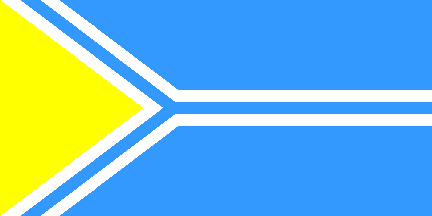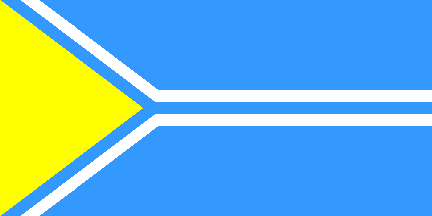
This page is part of © FOTW Flags Of The World website
Tuva (Russia)
Tuviniâ, Tannu Tuva
Last modified: 2007-06-09 by antónio martins
Keywords: tuva | error | tyva |
Links: FOTW homepage |
search |
disclaimer and copyright |
write us |
mirrors
Тува / Танну
Тува

image by Vincent Morley, 19 Nov 1997
See also:
Other sites:
Presentation of Tuva
(Note: You need an Unicode-aware software and font to correctely view the cyrillic text on this page. See here transliteration details).
- Name (english): Tuva • (russian, short form): Тува | Tuva • (russian, long form): Республика Тыва | Respublika Tyva • (local, short form): Танну Тува | Tannu Tuva
- Local official language: Tuvian
- Capital: Кызыл | Kyzyl
- Area: 170 500 km2 (≅65 800 sq.mi.) • Population: 311 200 inhabitants in 2000
- Status: Republic (Республика | Respublika) within the Russian Federation
- Federal District: Siberia • Economic region: East Siberia
- License plate code: 17 • Ham radio code: TU • ISO 3166-2 code: TY
- Flag adopted on 1992.09.17 • Coat of arms adopted on 1992.09.17
Tuva broke away from Mongolia in 1921, and retained its independence
until incorporation into the USSR in 1944. In 1961, it became an ASSR.
In 1992, a new flag of light blue, yellow and white was adopted.
Stuart Notholt, 25 Nov 1995
Tuva is currently an autonomous republic of Russia, but
was previously independent. The
area is near the border between
Siberia and
Mongolia, and
is also claimed by China (I think that
Taiwan even has a representative in
their legislature for Tuva, or at least they used to).
Annie Platoff
Tuva borders Mongolia to the
south and has a short border with
Buryatia to the east.
Tuvinian is a Turkic language and is most closely
related to Uighur, spoken in the Chinese region
of Sinkiang.
Vincent Morley, 19 Nov 1997
Discription and meaning of the flag
The original Tuvan flag
adopted in 1918 was also
blue, yellow and white. Today, the colours are
said to represent courage and strength in blue,
prosperity in yellow and purity in white.
Vincent Morely, 19 Aug 1997,
quoting [rya97]
Present flag of Tuva was designed by Oyun-ool Sat 18 September 1992.
White suggests silver (clean thoughts) and the silver streamers draped
over a hostess’ arms as she greets guests. Yellow suggests gold (riches)
as well as Buddhism. Light blue suggests the courage and firmness of the
nomadic herdsmen (and the big blue Tuvan sky!). The stripes represent the
confluence of the Bii-Khem and Kaa-Khem rivers at Kyzyl, where they form
the Ulug-Khem (Yenisei).
Dave Martucci 15 Mar 1998,
quoting Kerry Yackoboski
The Pantone colours proposed by
The Flag cabinet (Jiri Tenora, Berlin)
are: B- (PMS 285), Y (PMS 116).
Pascal Vagnat, 03 May 1998
Jiri Tenora’s proposal for the
blue is too dark. The many potographs
we have show a lighter shade: PMS 292
or even 291 is more correct. (The
picture above shows the colors very
good).
Ralf Stelter, 27 Jun 1999
Tuvan Government flag law
Ordinance on the state flag of the Republic of Tuva
(approved by the resolution of the Supreme Council of the Republic of
Tuva on the 17th September 1992, n°354)
-
- The state flag of the Republic of Tuva [RT in the rest of the text]
consists of a rectangular light blue cloth. From the upper and lower
corners near the hoist are going some oblique white and light blue
stripes. On the point where the stripes are meeting, the blue stripe is
becoming one only stripe which cross the middle of the flag until the
fly. The white stripes are parallel to it on its upper and its lower
side.
- The triangle being created by the white stripes, the upper and
lower corners near the hoist and the width of the flag is gold
(yellow).
- The ratio width/length is 1:2.
- The distance between the hoist and the intersection of the white
stripes is equal to one third of the length of the flag. The width of the
light blue stripes going from the upper and lower corners near the hoist
is 1/18th of the width of the flag. The distance between the external
side of the two white stripes along the length of the flag is equal to
1/6th of the width of the flag.
- The state flag of the RT is hoisted permanently:
- on the buildings where the Supreme Council of the RT, the president
and the governement of the RT are sitting.
- on the buildings of the local councils of the people’s deputies and
of the local administration.
- on the aircraft and ships for inland waterways belonging to the RT.
- The state flag of the RT is hoisted temporarily:
- on the building where the sessions of the supreme council of
the RT are taking place, during the sessions;
- on the buildings where the sessions of the local councils of
the people’s deputies are taking place, during the sessions;
- on the building of ministeries, state comitees and services,
states organisations and communities, firms and offices, on
official holydays and during solemn events;
- on the buildings where are working vote commissions and where
the elections are taking place, on the election and referenda days;
- in sport stadions - during the championship of the Republic,
the regional and international competitions and during the delivery of
medals to the victorious athlets of the RT;
- on the cars carrying high personalities of the RT - the
president of the Supreme Council of the RT and the President of the RT as
well as other official delegations of the RT;
- in other cases by order of the Supreme Council of the RT or of
the governement of the RT.
- It is allowed to use the reproduction of the state flag of the RT for
decorative purposes so that there is respect shown towards this state
symbol.
- It is possible to hoist the state flag of the RT with the agreement of
the governement of the RT during ceremonies and solemn occasions non
regarding the status of the organizers.
- If the flag of the RT is hoisted at the same time as the national flag
of the Russian Federation or the national flags of other states, the
hoisted flag shall have the same dimensions.
- The enforcement of the present ordinance shall be regulated with the
instructions of the government of the RT.
quoted by Pascal Vagnat, 03 May 1998
Incorrect design reported

image by Vincent Morley and António Martins, 12 Apr 2000
This (in medium blue) flag is listed under number 122 at the chart
Flags of Aspirant Peoples [eba94]
as: «Tuva Ulus (Tuvinian Mongols) - South Siberia». Similar to the
real flag, but no white stripe between the yellow triangle and the
blue field.
Ivan Sache, 15 Sep 1999
I wander if the missing white stripe is simply an error or if
it has a meaning as a variation of the Tuvan flag — for what is
worth, "Tuvinian Mongols" are simply Tuvans (or Tuvinian).
António Martins, 16 Sep 1999
Coat of arms
ty.gif)
image by Eric Slone
This emblem is remarkably similar to the one on the
1933-1941 flag.
António Martins, 15 Feb 2000
Historical Flags of Tuva
According to “State Flags and Coats
of Arms of Tuva” by Prof. V.A. Sokolov
[sol83a],
which appeared in the Flag Bulletin,
[tfb] issue
100 (May-Aug. 1983), there were
seven flags used between 1921 and 1944,
although only five were legally adopted. Add to that the two
ASSR Flags and the present
flag, making 10 flags in all since 1921.
Dave Martucci, 15 Mar 1998
Anything below
this line was not added by the editor of this page.



ty.gif)